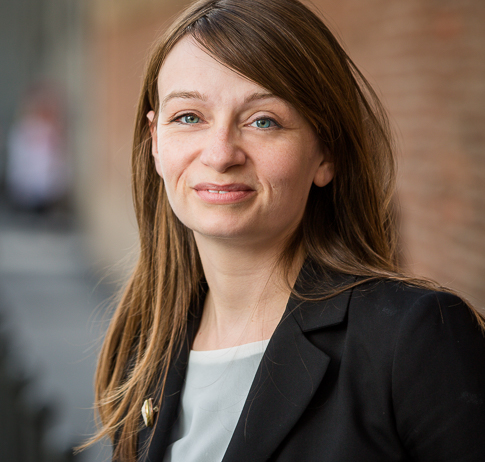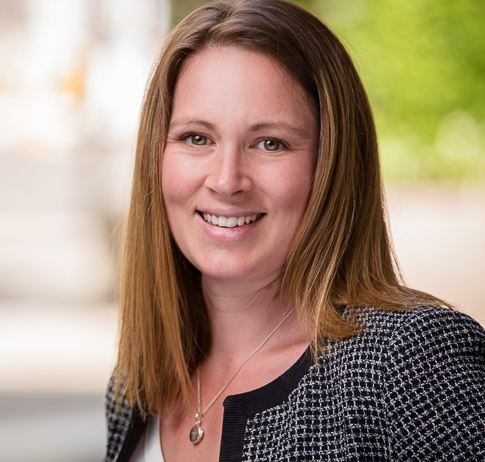Article
The startups creating a sparkling future for sustainable fashion
17 January 2024 | 4 minute read
"Sustainable textiles tend to be faded in color, often meaning an aesthetic compromise, underperforming and lacking excitement.” says Elissa Brunato.

Having spent several years working across design, technical development and production of some of the most vibrant British fashion brands, including Erdem and Peter Pilotto, the material designer knew these muted tones were not going to convert couture houses to using more sustainable materials. She chose to make it her mission to bridge the gap between aesthetic desires of the industry and a sustainable approach to materials.
It therefore felt like a huge achievement to open the spring 2023 edition of American VOGUE and see the model Cara Delevingne lounging across a double-page spread in a Stella McCartney jumpsuit sparkling with the natural sequins made by her startup, Radiant Matter.

"To see it there, fully glittering, on that platform, shot by Annie Leibovitz for the cover story – I am really proud of that material,” says Elissa. “It’s created from cellulose [a plant molecule] and structurally colored, mimicking the kind of vibrant, colorful shimmer you see on a peacock feather.”
Among Radiant Matter’s new challenges is now keeping up with the huge pent-up demand for sustainable sparkle – which was only compounded when Stella McCartney showed a BioSequin dress at her spring/summer 24 catwalk show. “Coming from the brand side, I kept hearing the same things from my contacts and the designers I was working with,” says its founder. “We rely on sequins, they bring excitement and joy to collections and add texture that couldn’t be replaced, but it feels disenchanting to imagine all this plastic we are attaching to garments and the environmental issue of this plastic ending up in all kinds of places around the world."

An Oxfam study in the UK pointed out that British women are particularly attracted to sparkling clothing during festive seasons, but send 1.7 million sequined items to landfill with the end of each season. Worn just a few times each, these products will never biodegrade. 1
"Coming from the brand side, I couldn't sit around waiting for someone to come up with a sustainable alternative, so I went back to university to do a Masters and graduated with the bio iridescent sequin project,” Elissa recalls.
At around the same time, fashion lover Jesse Adler was at the University of Michigan studying biomolecular science and considering a career in medicine. “I love science, design and helping people,” she says. “One day a friend told me, ‘I just went to the craziest lecture by this woman who’s making jackets from kombucha’. That was Suzanne Lee from BioFabricate. I looked into it and thought, this is so me.”

After graduating, Jesse moved to London, joined the renowned Materials Futures course at Central St Martins college that Elissa had completed a few years earlier, and threw herself into the sustainable fashion scene. She was quickly hired as a researcher for Pangaia, a materials science and fashion brand, a role that complemented the Masters perfectly.
“I realised there was a big gap in the market for natural color that had the same hues and vibrancy as synthetic color, particularly in beauty,” she says. “Even in the clean beauty movement and vegan beauty products, color is really overlooked. At the same time, I was learning about all these brilliant mushrooms, and thought, maybe we can harness that power.”
For her final-year project, Jesse extracted pigment from fungi to create a cosmetics line including lipsticks, eyeshadows and tinted skin creams. Like Elissa, she was overwhelmed by the response from the media and the industry, finding herself featured in Wallpaper magazine and invited to Dutch Design Week.

However, as a scientist she is determined to proceed with caution: “People are very excited and want to buy the products already. It’s an honor to have this excitement but I want to ensure we’re doing everything properly.”
Jesse is in the early stages of her startup and seeking grant funding to help her validate some mushroom-based colors from start to finish, ensuring they retain their vibrancy and are pH stable and non-toxic. “All those things are really important to a commercial colorant,” she says.
The founder describes herself as “application agnostic”, believing her business will have most impact with a white-label product for supply chain specialists to use in fashion, beauty and beyond. “I have no idea how to make printer ink, but it could just as easily be made from fungi as it is fossil fuels,” she suggests.
As concerns around climate change grow, bio-based color and sparkle look like a game-changer in the fashion and beauty world
"As concerns around climate change grow, bio-based color and sparkle look like a game-changer in the fashion and beauty world ,” comments Jacopo Liguori, Withers' IP partner based in Milan who advises numerous brands. “In our experience, new cosmetics products take years to develop and go through regulatory approval, but with so much demand for sustainability I expect bio-based colors to become the industry standard in the long run.”
Jesse’s next steps are to build a team that can help her scale production – a process she describes as akin to brewing beer – and then look for new colors in the relatively unexplored world of fungi. “It’s estimated there are millions of fungi out there and we’ve started studying about 1 per cent. Of those, there are hundreds that produce colors. Even as we get to 10 per cent, how many more will we be able to discover?”

The initial benefit is to cut out harmful fossil fuels from the supply chain, however Jesse believes bio-based colors could actually have benefits for consumers. “There are mushrooms out there with bioactive properties in the human body,” she explains. “Some are anti-inflammatory. Others offer UV protection. Could there be fungi that are anti-cancer? Ultimately we’re looking to work with color that is not only beautiful but beneficial. ”
Elissa, meanwhile, has recently brought on a female cofounder with a background in materials science, and the duo are seeking investment to develop their material platform technology into further applications addressing various markets that use color effects such as cosmetics, packaging and automotive. They are also working on the production of their BioSequins to feed the demand of couture houses and, eventually, the high street. “The demand is there and you can see it in our inbox daily,” she remarks. “We’re working with the luxury industry first because they'll adopt smaller quantities and then it’s about being able to scale in a way that means we can meet that wider demand.”
With endorsements from leading designers and media brands already under their belts, a sparkling future for both startups seems assured.
The Global Rethinkers
We're getting behind the innovators in fashion, beauty and retail. Check out our hub to find out more.






